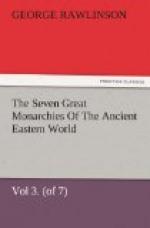Upon the whole it must be allowed that the towns of Media were few and of no great account. The Medes did not love to congregate in large cities, but preferred to scatter themselves in villages over their broad and varied territory. The protection of walls, necessary for the inhabitants of the low Mesopotamian regions, was not required by a people whose country was full of natural fastnesses to which they could readily remove on the approach of danger. Excepting the capital and the two important cities of Gazaca and Rhages, the Median towns were insignificant. Even those cities themselves were probably of moderate dimensions, and had little of the architectural splendor which gives so peculiar an interest to the towns of Mesopotamia. Their principal buildings were in a frail and perishable material, unsuited to bear the ravages of time; they have consequently altogether disappeared, and in the whole of Media modern researches have failed to bring to light a single edifice which can be assigned with any show of probability to the period of the Empire.
The plan adopted in former portions of this work makes it necessary, before concluding this chapter, to glance briefly at the character of the various countries and districts by which Media was bordered—the Caspian district upon the north, Armenia upon the north-west, the Zagros region and Assyria upon the west, Persia proper upon the south, and upon the east Sagartia and Parthia.
North and north-east of the mountain range which under different names skirts the southern shores of the Caspian Sea and curves round its south-western corner, lies a narrow but important strip of territory—the modern Ghilan and Mazanderan. [Plate II., Fig. 2.] This is a most fertile region, well watered and richly wooded, and forms one of the most valuable portions of the modern kingdom of Persia. At first it is a low flat tract of deep alluvial soil, but little raised above the level of the Caspian; gradually however it rises into swelling hills which form the supports of the high mountains that shut in this sheltered region, a region only to be reached by a very few passes over or through them. The mountains are clothed on this side nearly to their summit with dwarf oaks, or with shrubs and brushwood; while, lower down, their flanks are covered with forests of elms, cedars, chestnuts, beeches, and cypress trees. The gardens and orchards of the natives are of the most superb character; the vegetation is luxuriant; lemons, oranges, peaches, pomegranates, besides other fruits, abound; rice, hemp, sugar-canes, mulberries are cultivated with success; vines grow wild; and the valleys are strewn with flowers of rare fragrance, among which may be noted the rose, the honeysuckle, and the sweetbrier. Nature, however, with her usual justice, has balanced these extraordinary advantages with peculiar drawbacks; the tiger, unknown in any other part of Western Asia, here lurks in the thickets, ready to spring at any




